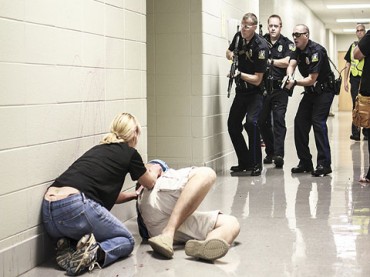
TUCSON, ARIZ.- In the spring of 2013, the University of Arizona came to a standstill after university police were notified a man armed with a rifle was reportedly on the loose in the administration building.
Officers surrounded the building, evacuated neighboring facilities and shut down nearby streets. They conducted a room-by-room search to find the shooter, but found no evidence of a shooting, perpetrator or gun-related injuries.
Although that incident was a false alarm, officers used response tactics they developed following a shooting on campus in 2002, when a disgruntled student shot and killed three professors at the nursing college before fatally turning the gun on himself.
The surge of shootings and gun-related crimes on college campuses in the past few decades have prompted campus safety officials to revise their active-shooter response plans.
But Friday night’s shootings in a town adjacent to the UC Santa Barbara campus shows how active-shooter plans may need to encompass nearby areas. A 22-year-old gunman allegedly killed seven people, himself included, in a string of shootings and stabbings.
At the time of the 2002 shooting, the standard response to active-shooter situations was for law enforcement officials to “wait for SWAT to show up,” or “surround the building, make sure we had plenty of resources before we go in and take care of the problem,” according to Officer George Eppley of the University of Arizona Police Department, in an interview with The College Fix.
Combined with other firearm-related crimes on college campuses, “the whole philosophy changed,” said Eppley, prompting university law enforcement officials to go back to the drawing board for their active-shooter response tactics.
Now, officers responding to the scene of an active-shooter situation immediately enter the building armed with rifles and the intent to locate and “eliminate” the suspect, Eppley said, meaning shoot to kill.
University law enforcement officials now undergo live-action active-shooter training at least on an annual basis, according to Eppley.
Training involves a simulated situation with a suspect, rifles that shoot paintball rounds and victims sprawled across the floor covered in fake blood with the end goal to go “in and eliminate the bad guy,” Eppley said.
Eppley feels the training effectively prepares officers to respond to the scene of an active-shooter situation, even though it’s just a training exercise.
“When you get there you know it’s all role playing, but when you see people laying on the ground and there’s some type of red food coloring that is on them,” he said, “it looks like the real thing.”
Many other institutions of higher education have begun to revise their response plans in the wake of the 2012 shooting at Sandy Hook Elementary School in Newtown, Connecticut, according to Robin Hattersley-Gray, executive editor of Campus Safety magazine.
An effective emergency response plan for active-shooter situations is crucial for the safety and security of college campuses, Hattersley-Gray said.
This year’s edition of the magazine’s annual safety report, The Campus Safety Yearbook, reveals that although 72 percent of campus safety officials are required to undergo some sort of active-shooter training, the current degree of preparation for active-shooter responses is far from ideal.
Only 21 percent of officials strongly agreed that their public safety department had enough, and the appropriate type, of lethal and “less-lethal” weapons to adequately respond to a weapons-related incident.
Less than a third of campus law enforcement and security officials carry lethal weapons on average, according to the study. Only 13 percent of officials carry non-lethal weapons.
Further, only 28 percent of officials felt that campus police officers or other persons responsible for campus security had received suitable training on handling lethal weapons.
However, the greatest challenge that lies ahead in increasing the effectiveness of response tactics is raising awareness and preparedness for active-shooter situations among non-security individuals on campus, said Hattersley-Gray.
Students and faculty should know what a gunshot sounds like, how to alert safety officials to a possible active-shooter situation, points of evacuation for an area and where to seek shelter if evacuation is impossible, according to Hattersley-Gray.
College Fix contributor Julianne Stanford is a student at the University of Arizona.
Like The College Fix on Facebook / Follow us on Twitter
IMAGE: Maximillian Curry/Flickr





Please join the conversation about our stories on Facebook, Twitter, Instagram, Reddit, MeWe, Rumble, Gab, Minds and Gettr.